Effect of Carbon Nanotube Content and Mechanical Milling Conditions on the Manufacture of AA7075/MWCNT Composites
Abstract
:1. Introduction
2. Materials and Methods
2.1. Raw Materials
2.2. AA7075-MWCNT Composite Powder Preparation
2.3. Material Characterization
3. Results and Discussion
3.1. Microstructural Characterization of Raw Materials
3.2. Morphology and Size Evolution of Composite Particles and Dispersion of MWCNTs
3.2.1. High-Energy Ball Milling (HEBM) Route
3.2.2. Low-Energy Ball Milling (LEBM) Route
3.2.3. High + Low-Energy Milling (H + LEBM) Route
3.3. Effect of Milling Conditions on Average Crystallite Size (ACS) and Lattice Strain (LS)
3.4. Effect of Cyclic Ball Milling Process on MWCNTs
3.5. Nanoindentation Results
4. Conclusions
- -
- The high-energy ball milling route (HEBM) strategy achieves good dispersion and integration of the nanotubes in the AA7075 particles for the two percentages of reinforcements tested after 4 h of milling. Therefore, the cyclic variation of the speed (1 min cycles with a 48 s stage at 1300 rpm and a 12 s stage at 1000 rpm) allows for a reduction in the milling time, obtaining average particle sizes of 72 µm for 0.5 wt.% and 54 µm for 1 wt.% MWCNTs.
- -
- The low-energy ball milling route (LEBM) does not effectively disaggregate the MWCNT bundles and does not achieve adequate dispersion and incorporation into the AA7075 particles in the considered milling time (4 h in 1 min cycles varying rotation speed from 300 rpm for 48 s to 200 rpm for 12 s). These processes could be improved by notably increasing the milling time, but this would make its industrial implementation difficult. Thus, this strategy was discarded.
- -
- The high + low-energy (H + LEBM) strategy (4 h HEBM of AA7075 powders with no nanotubes + 2 h LEBM with MWCNTs) allowed for the adequate dispersion of the nanotubes, achieving their integration on the surface of the powders. In subsequent work, we will tested whether this “core-shell” structure can lead, after extrusion, to composites with heterogeneous microstructures and improved properties. The average particle size obtained via this route is 66 µm with 0.5 wt.% and 52 µm with 1 wt.% MWCNTs.
- -
- The nanoindentation technique makes it possible to verify that the highest E and H values are achieved in the samples with 0.5 wt.% MWCNTs produced by the H + LEBM milling route.
- -
- In the characterization carried out through Raman spectroscopy, the values of the ID/IG ratio determined form the spectra indicate that there is no significant difference in the damage induced in the MWCNTs in the two milling routes analysed. This is consistent with the fact that the stage that the two routes have in common is initial high-energy milling for 4 h, in which the maximum deformation of the powders and reinforcements occurs. It is significant to note that the difference in distortion detected in the MWCNTs in the as-received state is not relevant.
- -
- Moreover, the presence of a small amount of Al4C3 is detected in composites obtained from both routes due to the reaction of C with Al from the matrix.
- -
- After the performed XRD study, the average crystallite size obtained at the end of both HEBM and H + LEBM is similar (approximately 30 nm), representing a reduction of ~40% with respect to the as-received AA7075 powders. The most important crystallite size reduction takes place in the first two hours of milling, and the presence of nanotubes, at least in the proportions considered, seems to be irrelevant.
- -
- Based on the obtained results, especially those with respect to mechanical properties, it seems that the best option is to use 0.5% MWCNTs, regardless of the route followed.
Author Contributions
Funding
Data Availability Statement
Conflicts of Interest
References
- Koli, D.K.; Agnihotri, G.; Purohit, R. Advanced Aluminum Matrix Composites: The Critical Need of Automotive and Aerospace Engineering Fields. Mater. Today Proc. 2015, 2, 3032–3041. [Google Scholar] [CrossRef]
- Fogagnolo, J.B.; Velasco, F.; Robert, M.H.; Torralba, J.M. Effect of mechanical alloying on the morphology, microstructure and properties of aluminum matrix composite powders. Mater. Sci. Eng. 2003, A342, 131–143. [Google Scholar] [CrossRef]
- Zhao, N.; Nash, P.; Yang, X. The effect of mechanical alloying on SiC distribution and the properties of 6061 aluminum composite. J. Mater. Process. Technol. 2005, 170, 586–592. [Google Scholar] [CrossRef]
- Yao, X.; Zheng, Y.F.; Liang, J.M.; Zhang, D.L. Microstructures and tensile mechanical properties of an ultrafine grained AA6063-5 vol% SiC metal matrix nanocomposite synthesized by powder metallurgy. Mater. Sci. Eng. 2015, A648, 225–234. [Google Scholar] [CrossRef]
- Chen, C.-L.; Lin, C.-H. Effect of Y2O3 and TiC reinforcement particles on intermetallic formation and hardness of Al 6061 composites via mechanical alloying and sintering. Metall. Mater. Trans. A 2015, 46, 3687–3695. [Google Scholar] [CrossRef]
- Abreu, C.; Acuña, R.; Cristóbal, M.J.; Verdera, D.; Llovo, C. Friction Stir Processing Strategies to develop a surface layer composite on AA6061-T6. Mater. Manuf. Process. 2018, 33, 1133–1140. [Google Scholar]
- Acuña, R.; Cristóbal, M.J.; Abreu, C.; Cabeza, M. Microstructure and Wear Properties of Surface Composite Layer Produced by Friction Stir Processing (FSP) in AA2024-T351 Aluminum Alloy. Metall. Mater. Trans. A 2019, 50, 2860–2874. [Google Scholar] [CrossRef]
- Gandra, J.; Miranda, R.; Vila, P.; Velhinho, A.; Pamies, J.; Teixeira, A.V.; Pamiès Teixeira, J. Functionally Graded Materials Produced by friction stir processing. J. Mater. Process. Technol. 2011, 211, 1659–1668. [Google Scholar] [CrossRef]
- Feijoo, I.; Cabeza, M.; Merino, P.; Pena, G.; Rey, P. Age Hardening of Extruded AA 6005A Aluminum Alloy Powders. Materials 2019, 12, 2316. [Google Scholar] [CrossRef] [Green Version]
- Eatemadi, A.; Daraee, H.; Karimkhanloo, H.; Kouhi, M.; Zarghami, N.; Akbarzadeh, A.; Abasi, M.; Hanifehpour, Y.; Joo, S.W. Carbon nanotubes: Properties, synthesis, purification, and medical applications. Nanoscale Res. Lett. 2014, 9, 393. [Google Scholar] [CrossRef] [Green Version]
- Peng, T.; Chang, I. Mechanical alloying of multi-walled carbon nanotubes reinforced aluminum composite powder. Powder Technol. 2014, 266, 7–15. [Google Scholar] [CrossRef]
- Park, G.; Keum, D.H.; Lee, Y.H. Strengthening mechanisms in carbon nanotube-reinforced aluminum composites. Carbon 2015, 95, 690–698. [Google Scholar] [CrossRef]
- Li, Z.; Jiang, L.; Fan, G.; Xu, Y.; Zhang, D.; Chen, Z. Humphries, High volume fraction and uniform dispersion of carbon nanotubes in aluminium powders. Micro. Nan. Lett. 2010, 5, 379–381. [Google Scholar] [CrossRef]
- Cui, H.; Yan, X.; Monasterio, M.; Xing, F. Effects of various surfactants on the dispersion of MWCNTs–OH in aqueous solution. Nanomaterials 2017, 7, 262. [Google Scholar] [CrossRef] [Green Version]
- Guo, B.; Zhang, X.; Cen, X.; Chen, B.; Wang, X.; Song, M.; Ni, S.; Yi, J.; Shen, T.; Du, Y. Enhanced mechanical properties of aluminum based composites reinforced by chemically oxidized carbon nanotubes. Carbon 2018, 139, 459–471. [Google Scholar] [CrossRef]
- Nyanor, P.; Bahador, A.; El-Kady, O.A.; Umeda, J.; Kondoh, K.; Hassan, M.A. Improved ductility of spark plasma sintered aluminium-carbon nanotube composite through the addition of titanium carbide microparticles. Mater. Sci. Eng. A 2020, 795, 139959. [Google Scholar] [CrossRef]
- Mohammed, S.M.A.K.; Chen, D.L. Carbon Nanotube-Reinforced Aluminum Matrix Composites. Adv. Eng. Mater. 2020, 22, 12–27. [Google Scholar] [CrossRef]
- Choi, H.J.; Shin, J.H.; Min, B.H.; Park, J.S.; Bae, D.H. Reinforcing effects of carbon nanotubes in structural aluminum matrix nanocomposites. J. Mater. Res. 2009, 24, 2610–2616. [Google Scholar] [CrossRef]
- Deng, C.F.; Wang, D.Z.; Zhang, X.X.; Li, A.B. Processing and properties of carbon nanotubes reinforced aluminum composites. Mater. Sci. Eng. A 2007, 444, 138–145. [Google Scholar] [CrossRef]
- George, R.; Kashyap, K.T.; Rahul, R.; Yamdagni, S. Strengthening in carbon nanotube/aluminum (CNT/Al) composites. Scr. Mater. 2005, 53, 1159–1163. [Google Scholar] [CrossRef]
- Zhang, D.L. Processing of advanced materials using high-energy mechanical milling. Prog. Mater. Sci. 2004, 49, 537–560. [Google Scholar] [CrossRef]
- Poirier, D.; Gauvin, R.; Robin, A.L.D. Structural Characterization of a Mechanically Milled Carbon Nanotube/Aluminum. Mixture. Compos. A 2009, 40, 1482–1489. [Google Scholar] [CrossRef]
- Morsi, K.; Esawi, A. Effect of mechanical alloying time and carbon nanotube (CNT) content on the evolution of aluminum (Al)–CNT composite powders. J. Mater. Sci. 2007, 42, 4954–4959. [Google Scholar] [CrossRef]
- Liu, Z.Y.; Xu, S.J.; Xiao, B.L.; Xue, P.; Wang, W.G.; Ma, Z.Y. Effect of ball-milling time on mechanical properties of carbon nanotubes reinforced aluminum matrix composites. Compos. Part A Appl. Sci. Manuf. 2012, 43, 2161–2168. [Google Scholar] [CrossRef]
- Choi, H.J.; Shin, J.H.; Bae, D.H. The effect of milling conditions on microstructures and mechanical properties of Al/MWCNT composites. Compos. Part A Appl. Sci. Manuf. 2012, 43, 1061–1072. [Google Scholar] [CrossRef]
- Deng, C.; Zhang, X.X.; Wang, D.; Lin, Q.; Li, A.B. Preparation and Characterization of Carbon Nanotubes/Aluminum Matrix. Compos. Mater. Lett. 2007, 61, 1725–1728. [Google Scholar] [CrossRef]
- Wei, H.; Li, Z.; Xiong, D.B.; Tan, Z.; Fan, G.; Qin, Z.; Zhang, D. Towards Strong and Stiff Carbon Nanotube-Reinforced High-Strength Aluminum Alloy Composites Through a Micro-laminated Architecture Design. Scr. Mater. 2014, 75, 30–33. [Google Scholar] [CrossRef]
- Travessa, D.N.; Da Rocha, G.V.B.; Cardoso, K.R.; Lieblich, M. Carbon Nanotube-Reinforced Aluminum Matrix Composites Produced by High-Energy Ball Milling. J. Mater. Eng. Perform. 2017, 26, 2998–3006. [Google Scholar] [CrossRef]
- Uriza-Vega, E.; Carreño-Gallardo, C.; López-Meléndez, C.; Cuadros-Lugo, E.; Pérez-Bustamante, R.; Ledezma-Sillas, E.; Herrera-Ramirez, J.M. Mechanical Behavior of Multiwalled Carbon Nanotube Reinforced 7075 Aluminum Alloy Composites Prepared by Mechanical Milling and Hot Extrusion. Mater. Res. 2019, 22, e20180652. [Google Scholar] [CrossRef]
- Jagannatham, M.; Senthil Saravanan, M.S.; Sivaprasad, K.; Kumaresh Babu, S.P. Mechanical and Tribological Behavior of Multiwalled Carbon Nanotubes-Reinforced AA7075 Composites Prepared by Powder Metallurgy and Hot Extrusion. J. Mater. Eng. Perform. 2018, 27, 5675–5688. [Google Scholar] [CrossRef]
- Zhang, H.B.; Wang, B.; Zhang, Y.T.; Li, Y.; He, J.L.; Zhang, Y.F. Influence of aging treatment on the microstructure and mechanical properties of CNTs/7075 Al composites. J. Alloys Compd. 2020, 814, 152357. [Google Scholar] [CrossRef]
- Esawi, A.M.K.; Morsi, K.; Sayed, A.; Taher, M.; Lanka, S. Effect of carbon nanotube (CNT) content on the mechanical properties of CNT-reinforced aluminum composites. Compos. Sci. Technol. 2010, 70, 2237–2241. [Google Scholar]
- Cabeza, M.; Merino, P.; Rey, P.; Román, M. Development of a high wear resistance aluminium matrix nanoreinforced composite. Surf. Interface Anal. 2012, 44, 1005–1008. [Google Scholar] [CrossRef]
- Suryanarayana, C.; Norton, M.G. X-ray Diffraction: A Practical Approach; Plenum Press: New York, NY, USA, 1998. [Google Scholar]
- Srinivasan, R.; Yogamalar, N.R.; Joseyphus, R.J.; Bose, A.C. Estimation of lattice strain, stress, energy density and crystallite size of the spherical yttrium oxide nanoparticles. Funct. Mater. Lett. 2009, 2, 131–134. [Google Scholar] [CrossRef]
- Oliver, W.C.; Pharr, G.M. An improved technique for determining hardness and elastic modulus using load and displacement sensing indentation experiments. J. Mater. Res. 1992, 7, 1564–1583. [Google Scholar] [CrossRef]
- Salem, H.G.; El-Eskandarany, S.; Kandil, A.; Fattah, H.A. Bulk Behavior of Ball Milled AA2124 Nanostructured Powders Reinforced with TiC. J. Nanomater. 2009, 479185. [Google Scholar] [CrossRef] [Green Version]
- Molnárová, O.; Málek, P.; Lukáč, F.; Chráska, T. Spark Plasma Sintering of a Gas Atomized Al7075 Alloy: Microstructure and Properties. Materials 2016, 9, 1004. [Google Scholar] [CrossRef] [Green Version]
- Abdullah, M.P.; Zulkeplia, S.A. The Functionalization and Characterization of Multi-walled Carbon Nanotubes (MWCNTs). In AIP Conference Proceedings; AIP Publishing LLC: Melville, NY, USA, 2015; Volume 1678, p. 050033. [Google Scholar] [CrossRef]
- Atchudan, R.; Pandurangan, A.; Joo, J. Effects of Nanofillers on the Thermo-Mechanical Properties and Chemical Resistivity of Epoxy Nanocomposites. J. Nanosci. Nanotechnol. 2015, 15, 4255–4267. [Google Scholar] [CrossRef]
- Wua, X.; Zhu, Y. Heterogeneous materials: A new class of materials with unprecedented mechanical properties. Mater. Res. Lett. 2017, 5, 527–532. [Google Scholar] [CrossRef]
- Saba, F.; Nateq, B.; Sajjadi, S.A.; Zhang, F.; Heydari, S. The enhanced mechanical properties and strain-hardening capability of CNT/Al composites achieved by heterogeneous micro-laminated architecture. Compos. Commun. 2021, 27, 100861. [Google Scholar] [CrossRef]
- Esawi, A.M.K.; Morsi, K.; Sayed, A.; Gawad, A.A.; Borah, P. Fabrication and properties of dispersed carbon nanotube–aluminum composites. Mater Sci. Eng. A 2009, 508, 167–173. [Google Scholar] [CrossRef]
- Choi, H.J.; Kwon, G.B.; Lee, G.Y.; Bae, D.H. Reinforcement with carbon nanotubes in aluminum matrix composites. Scr. Mater. 2008, 59, 360–363. [Google Scholar] [CrossRef]
- Cullity, B.D. Elements of X-ray Diffraction, 3rd ed.; Prentice Hall, Addison-Wesley Publishing Company Inc.: Boston, MA, USA, 2001. [Google Scholar]
- Daly, R.; Khitouni, M.; Kolsi, A.W.; Njah, N. The studies of crystallite size and microstrains in aluminum powder prepared by mechanical milling. Phys. Stat. Sol. 2006, 9, 3325–3331. [Google Scholar] [CrossRef]
- Sivasankarana, S.; Sivaprasad, K.; Narayanasamya, R.; Vijay Kumar, I. Synthesis, structure and sinterability of 6061 AA100−x–x %wt TiO2 composites prepared by high-energy ball milling. J. Alloys Compd. 2010, 491, 712–721. [Google Scholar] [CrossRef]
- Toozandehjani, M.; Matori, K.A.; Ostovan, F.; Abdul Aziz, S.; Mamat, M.S. Effect of Milling Time on the Microstructure, Physical and Mechanical Properties of Al-Al2O3 Nanocomposite Synthesized by Ball Milling and Powder Metallurgy. Materials 2017, 10, 1232. [Google Scholar] [CrossRef] [Green Version]
- Cabeza, M.; Feijoo, I.; Merino, P.; Pena, G.; Pérez, M.C.; Cruz, S.; Rey, P. Effect of high energy ball milling on the morphology, microstructure and properties of nano-sized TiC particle-reinforced 6005A aluminum alloy matrix composite. Powder Technol. 2017, 321, 31–43. [Google Scholar] [CrossRef]
- Sivasankarana, S.; Sivaprasadb, K.; Narayanasamya, R.; Satyanarayanac, P.V. X-ray peak broadening analysis of AA 6061100−x %wt Al2O3 nanocomposite prepared by mechanical alloying. Mater. Charact. 2011, 62, 661–672. [Google Scholar] [CrossRef]
- Basariya, M.R.; Srivastava, V.; Mukhopadhyay, N. Microstructural characteristics and mechanical properties of carbon nanotube reinforced aluminum alloy composites produced by ball milling. Mater. Des. 2014, 64, 542–549. [Google Scholar] [CrossRef]
- Ahamed, H.; Senthilkumar, V. Role of nano-size reinforcement and milling on the synthesis of nano-crystalline aluminum alloy composites by mechanical alloying. J. Alloys Compd. 2010, 505, 772–782. [Google Scholar] [CrossRef]
- Iijima, S. Helical microtubules of graphitic carbon. Nature 1991, 354, 56–58. [Google Scholar] [CrossRef]
- Dresselhausa, M.S.; Dresselhausb, G.; Saitoc, R.; Jorio, A. Raman spectroscopy of carbon nanotubes. Phys. Rep. 2005, 409, 47–99. [Google Scholar] [CrossRef]
- Lehman, J.H.; Terrones, M.; Mansfield, E.; Hurst, K.E.; Meunier, V. Evaluating the characteristics of multiwall carbon nanotubes. Carbon 2011, 49, 2581–2602. [Google Scholar] [CrossRef]
- Datsyuk, V.; Kalyva, M.; Papagelis, K.; Parthenios, J.; Tasis, D.; Siokou, A.; Kallitsis, I.; Galiotis, C. Chemical oxidation of multiwalled carbon nanotubes. Carbon 2008, 46, 833–840. [Google Scholar] [CrossRef]
- Xu, Z.Y.; Li, C.J.; Li, K.R.; Yi, J.H.; Tang, J.J.; Zhang, Q.X.; Liu, X.Q.; Bao, R.; Li, X. Carbon nanotube-reinforced aluminum matrix composites enhanced by grain refinement and in situ precipitation. J. Mater. Sci. 2019, 54, 8655–8664. [Google Scholar] [CrossRef]
- Jagannatham, M.; Chandran, P.; Sankaran, S.; Haridoss, P.; Nayan, N.; Bakshi, S.R. Tensile properties of carbon nanotubes reinforced aluminum matrix composites: A review. Carbon 2020, 160, 14–44. [Google Scholar] [CrossRef]
- Sridhar, I.; Narayan, K.R. Processing and characterization of MWCNT reinforced aluminum matrix composites. J. Mater. Sci. 2009, 44, 1750–1756. [Google Scholar] [CrossRef]
- Bakshi, S.R.; Singh, V.; Seal, S.; Agarwal, A. Aluminum composite reinforced with multiwalled carbon nanotubes from plasma spraying of spray dried powders. Surf. Coat. Technol. 2009, 203, 1544–1554. [Google Scholar] [CrossRef]
- Gowda Ashwin, C.; Girish, P. Study of Nanoindentation Characteristics of Al/B4C/CNT Composites. J. Nanosci. Nanoeng. Appl. 2016, 6, 7–12. [Google Scholar]
- Abdullahi, U.; Maleque, A.M.; Ali, M.Y. Hardness behaviour of carbon nanotube-aluminum nano-composite using nanoindentation technique. Mater. Today Proc. 2021, 46, 6097–6101. [Google Scholar] [CrossRef]
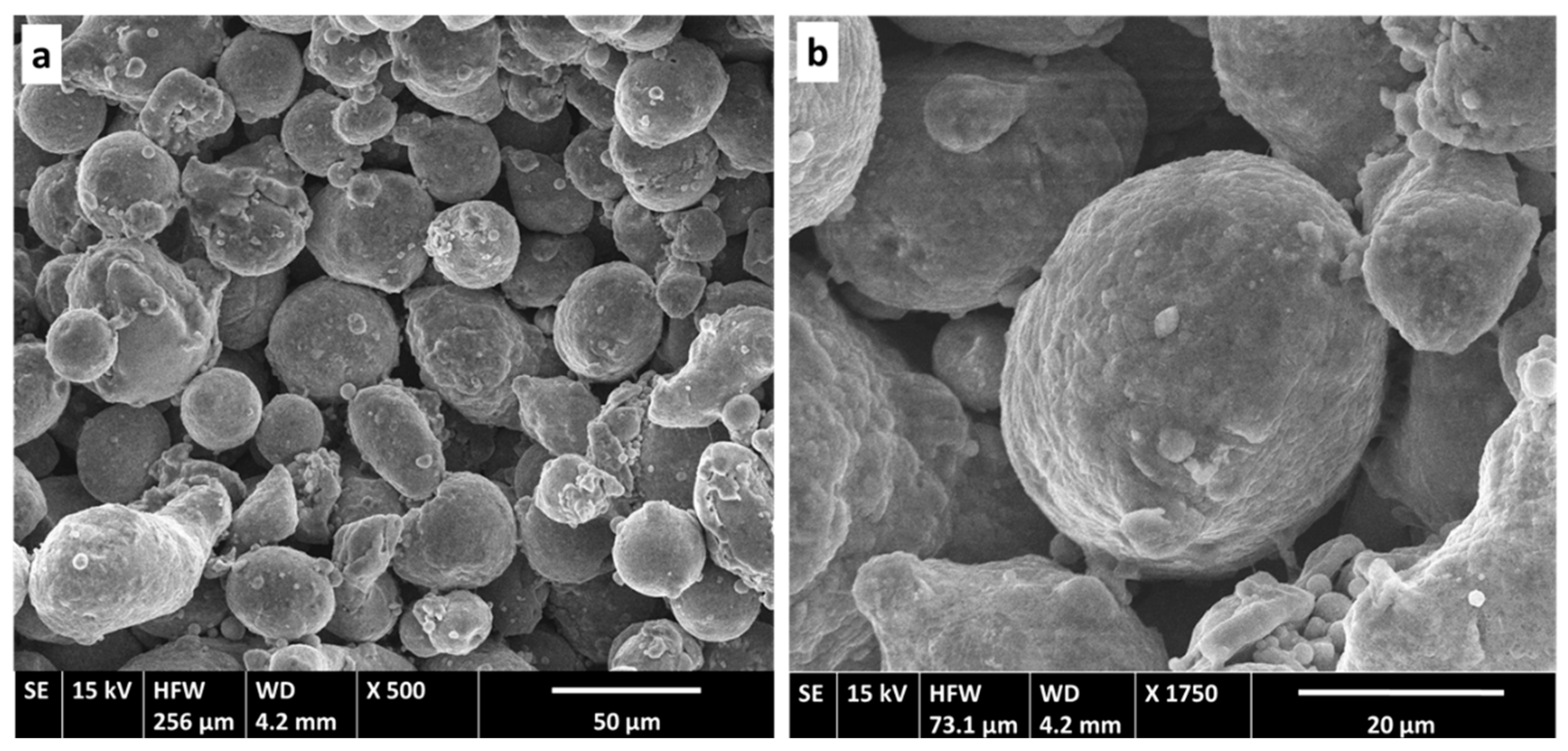
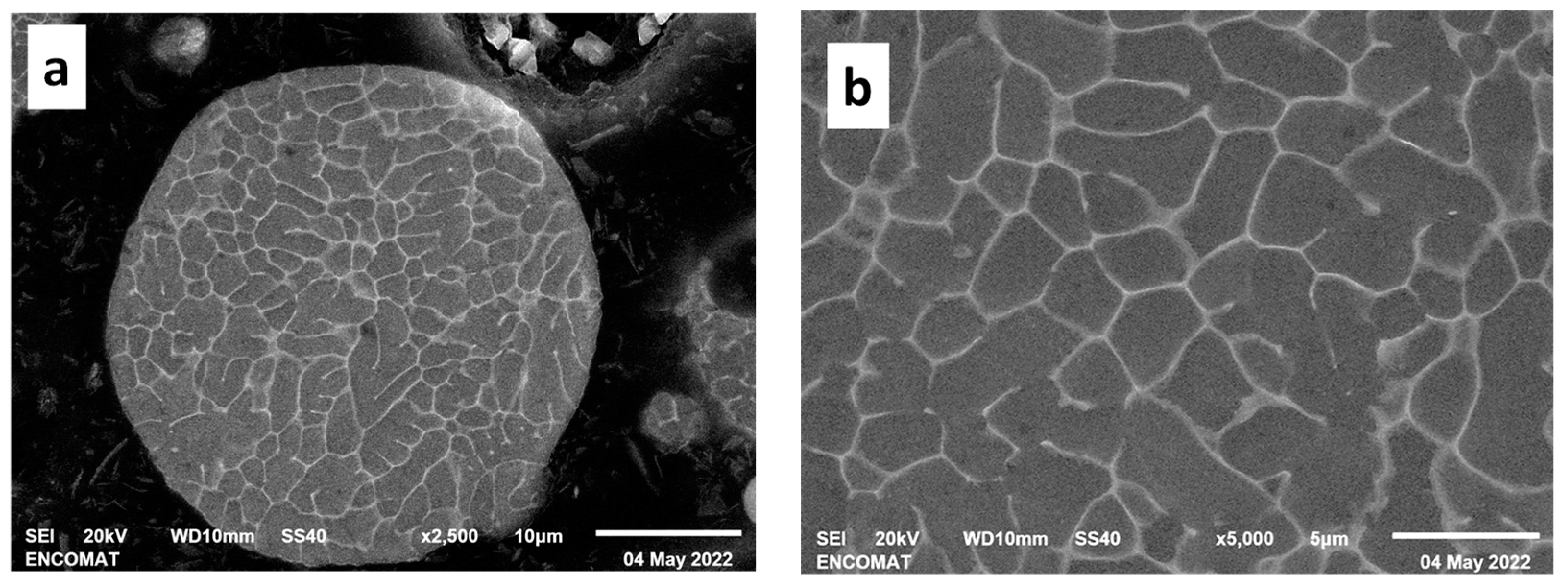
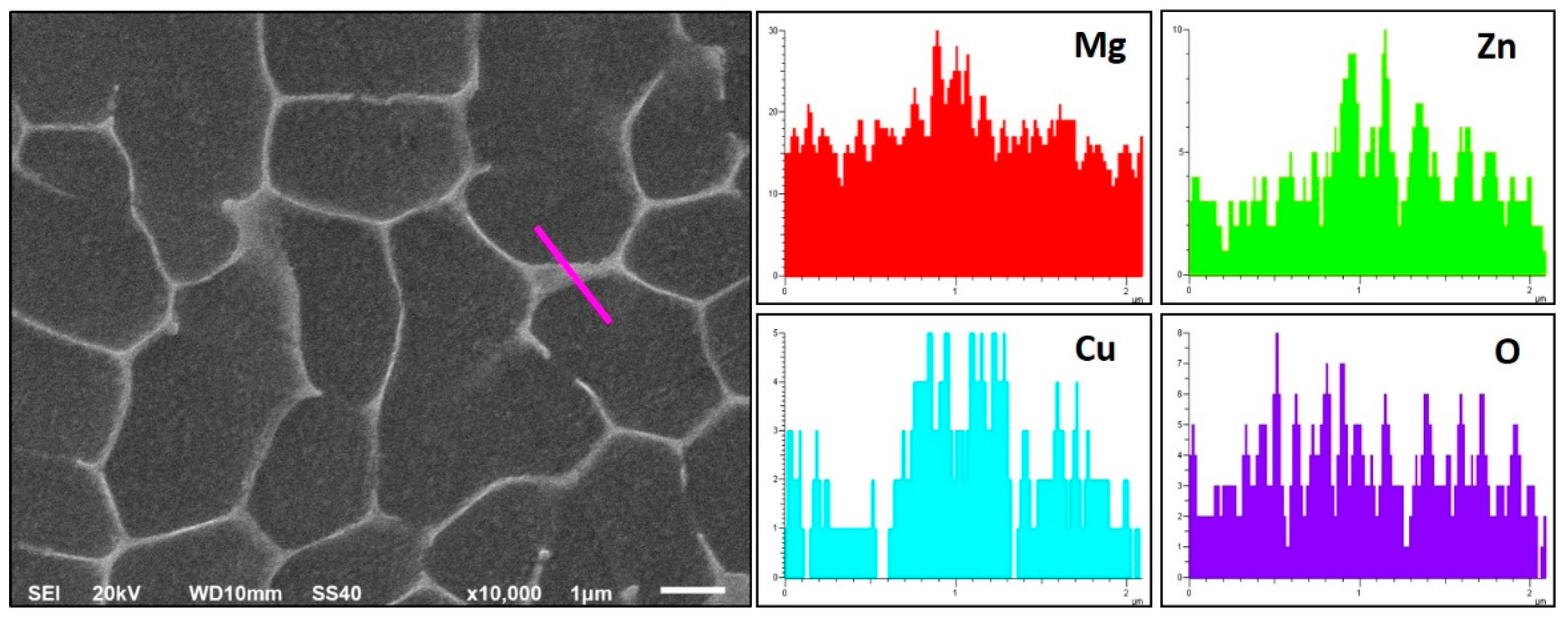
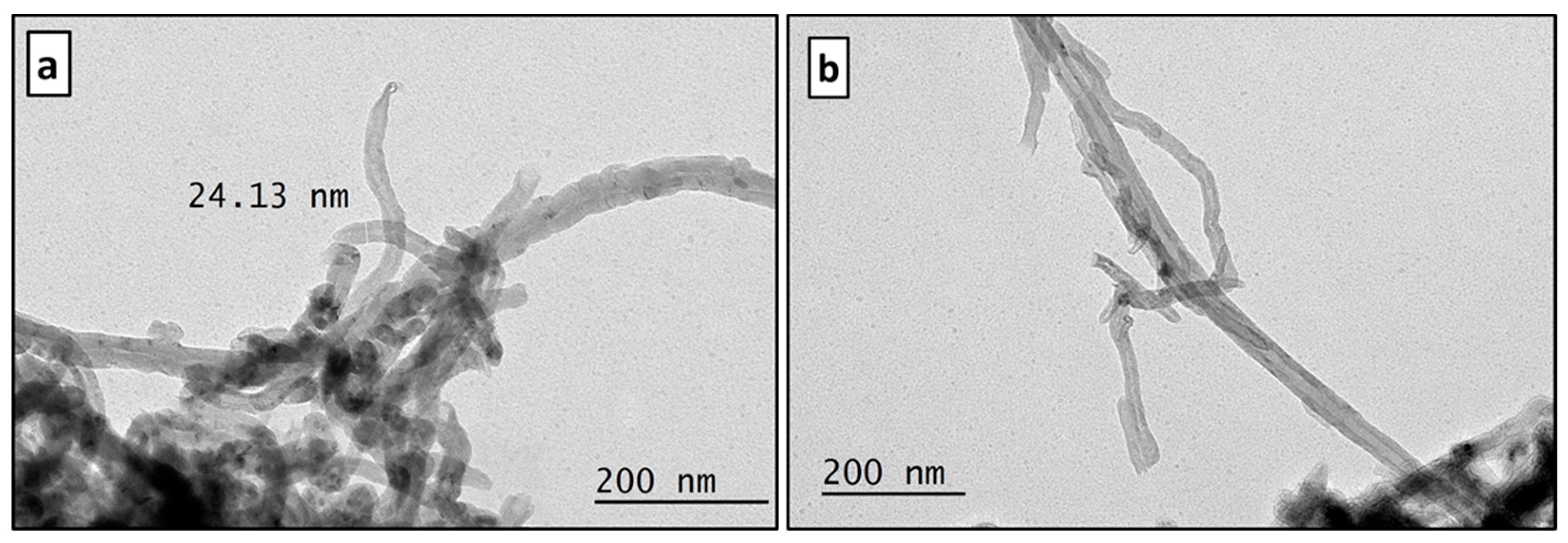
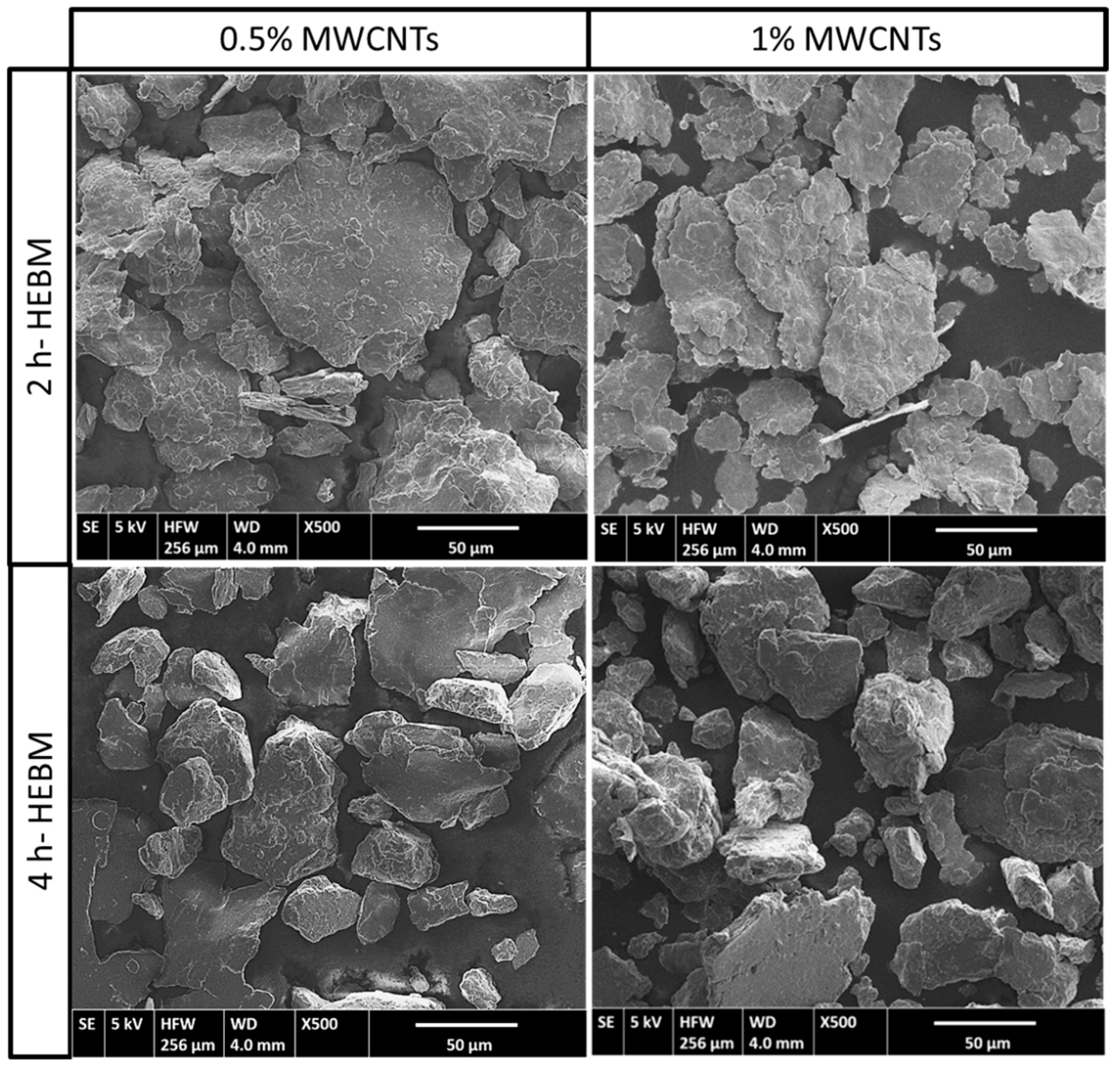
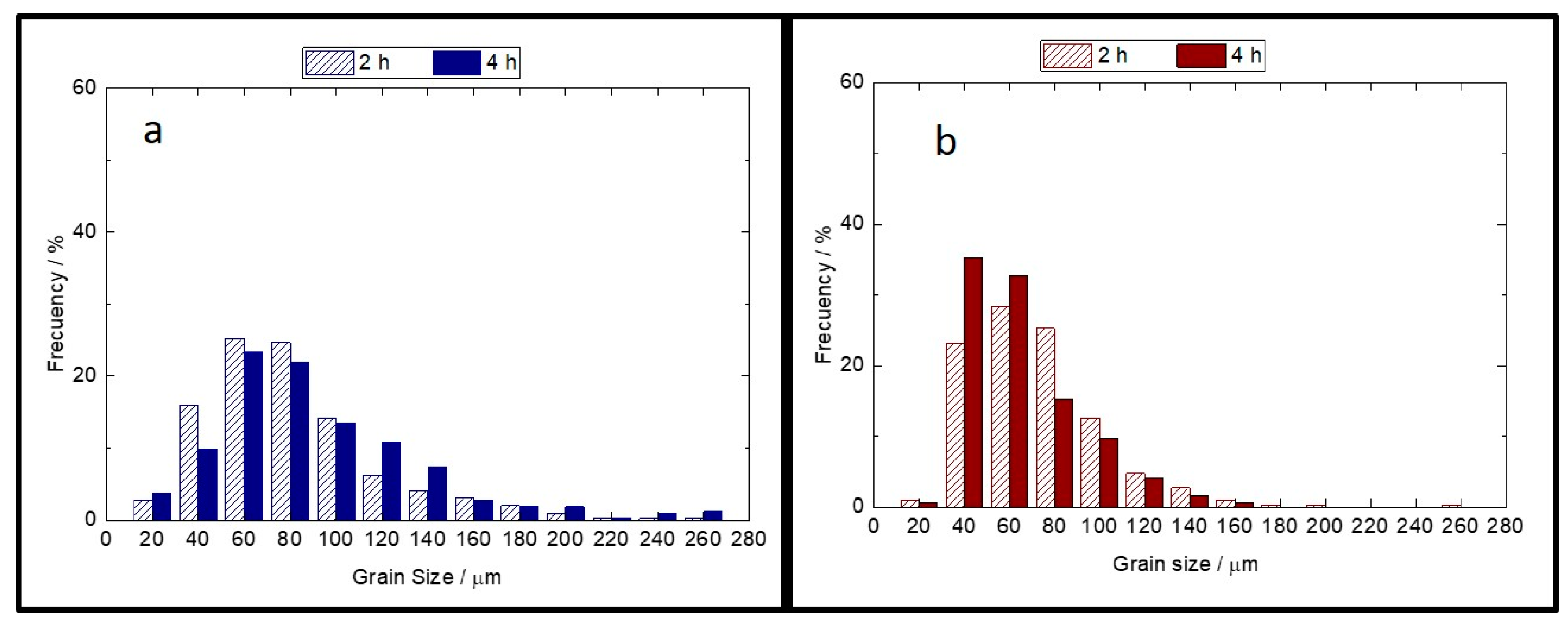
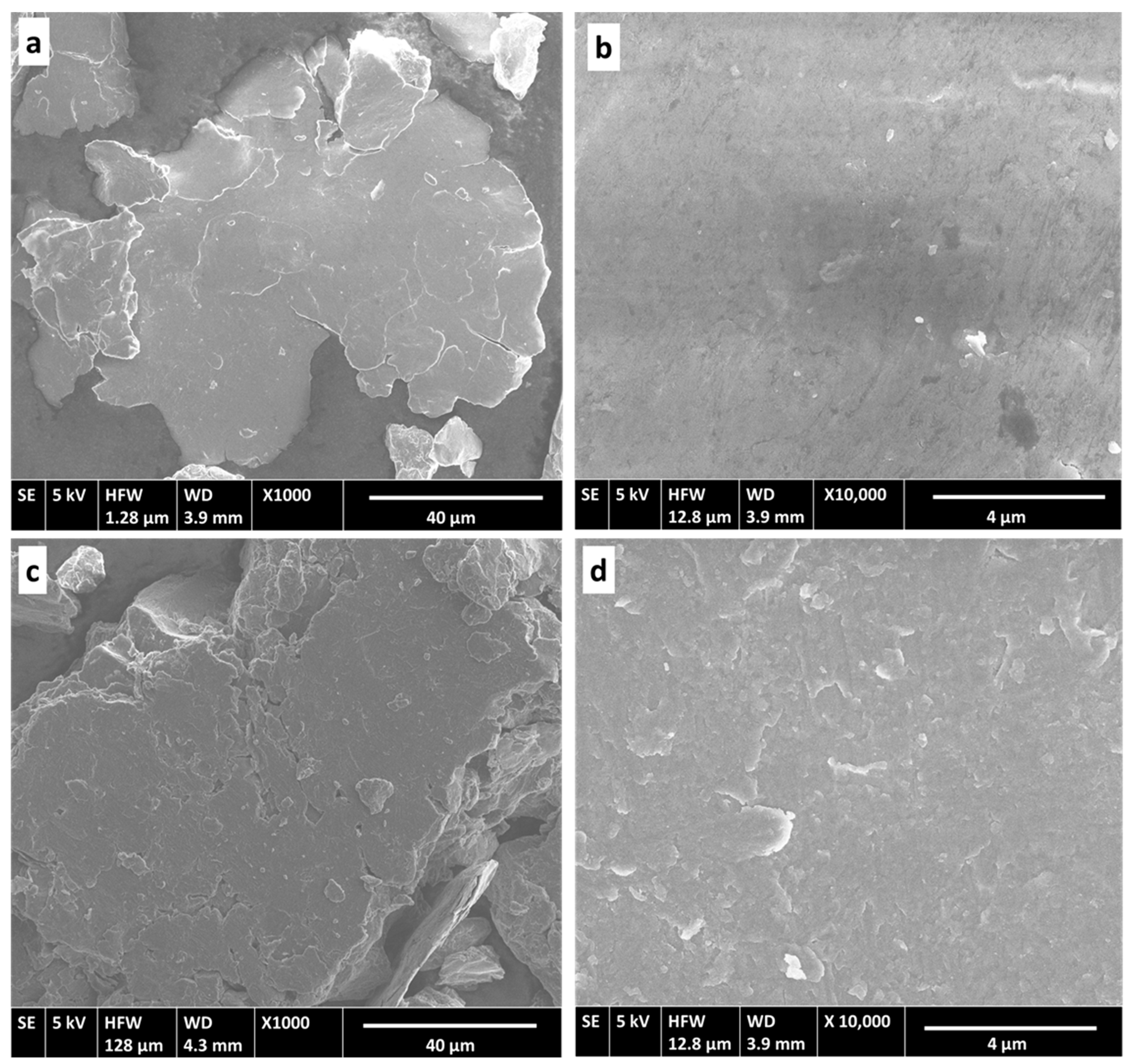
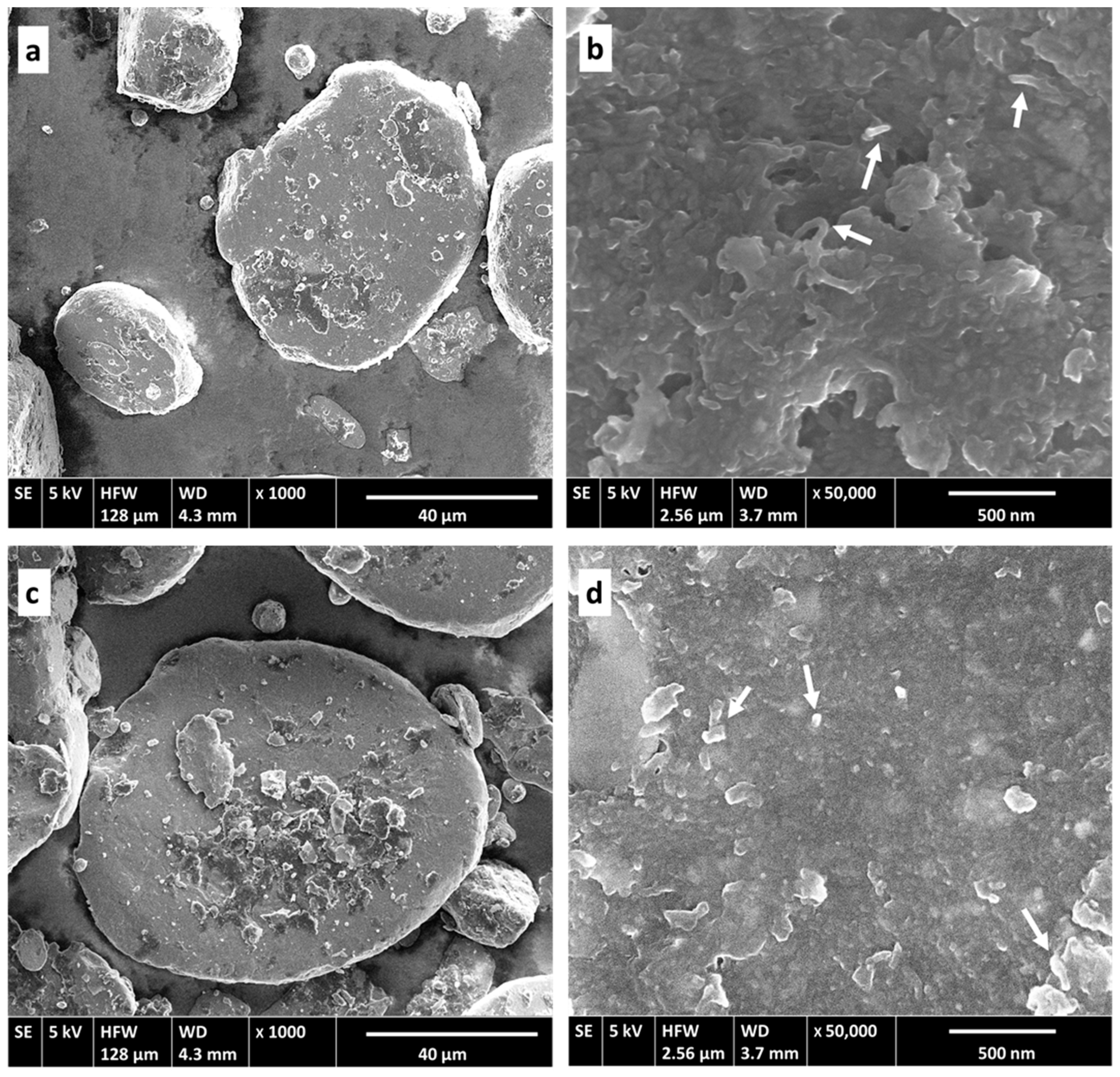
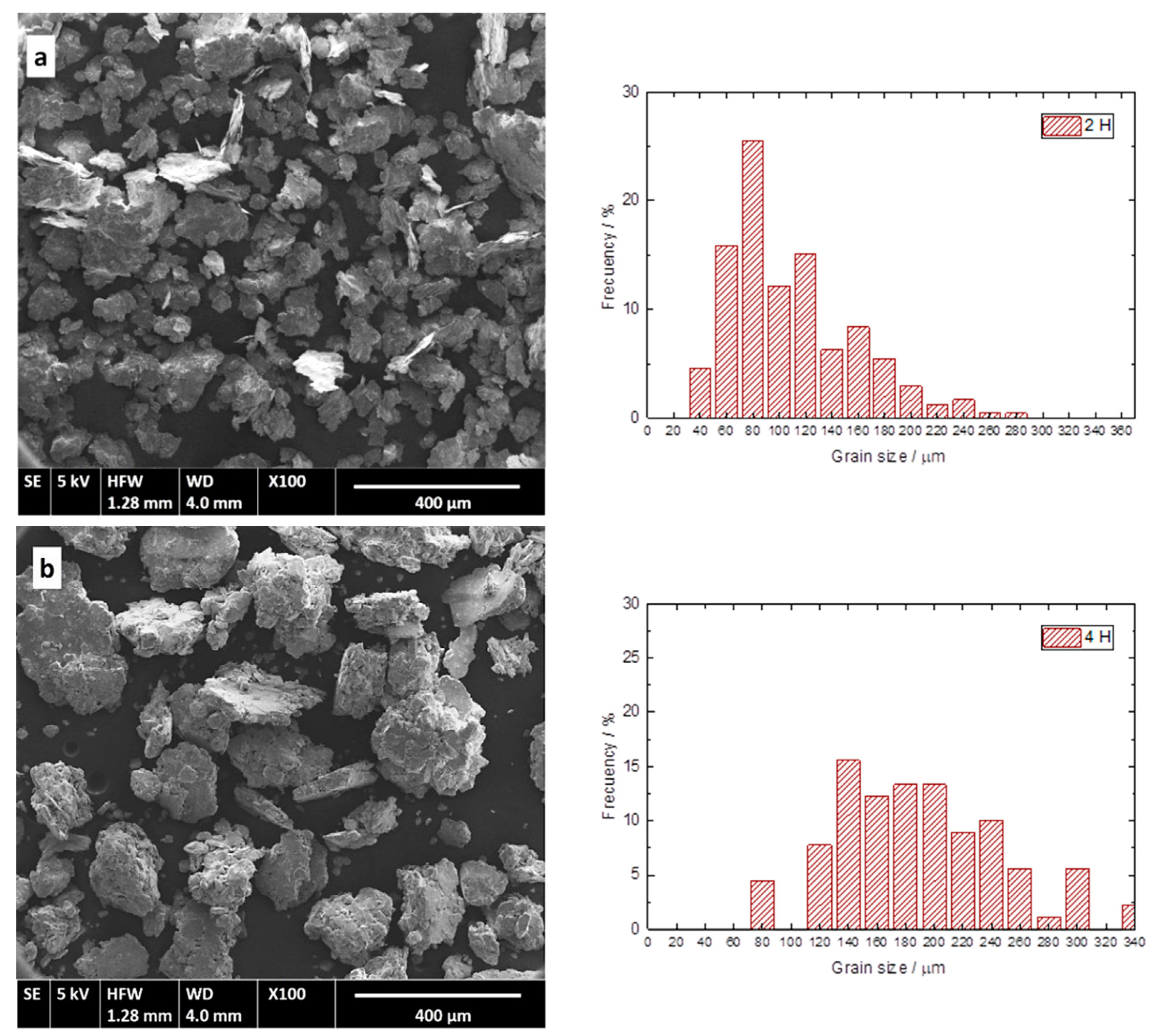
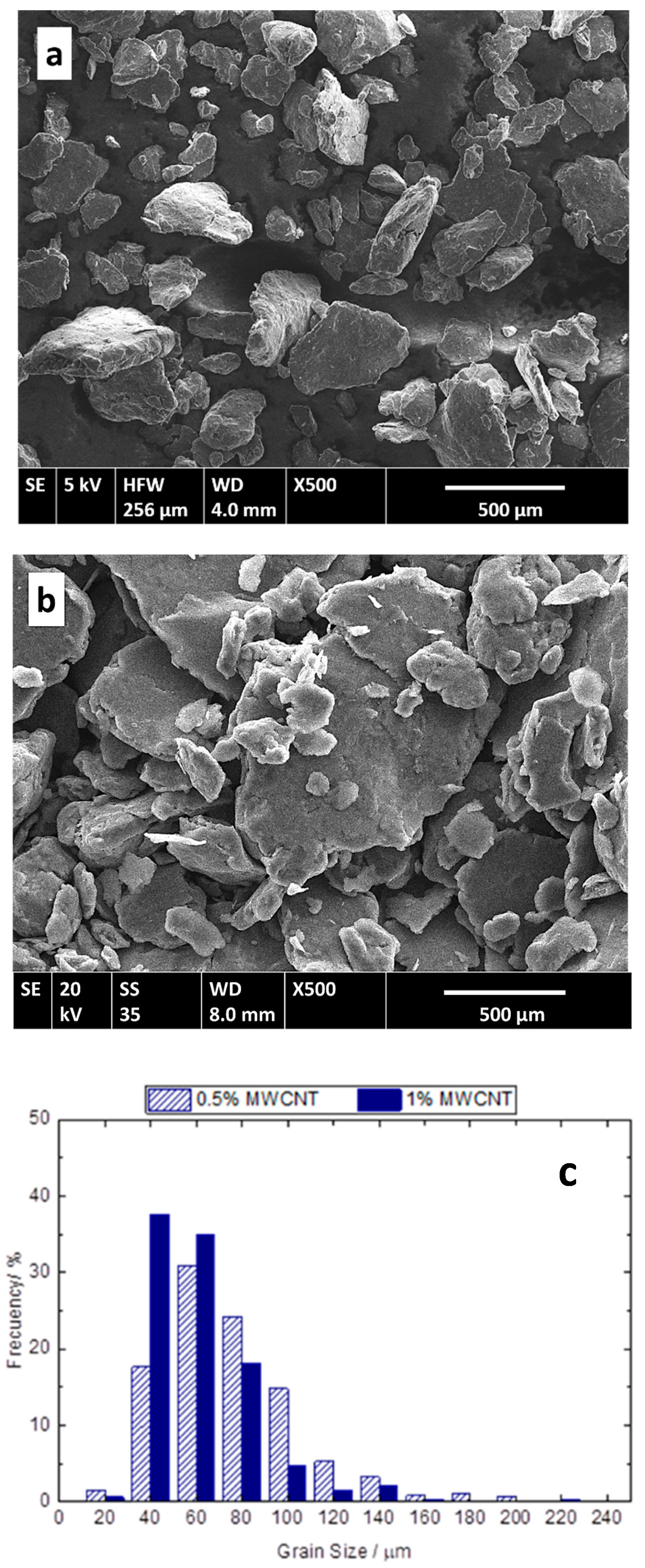

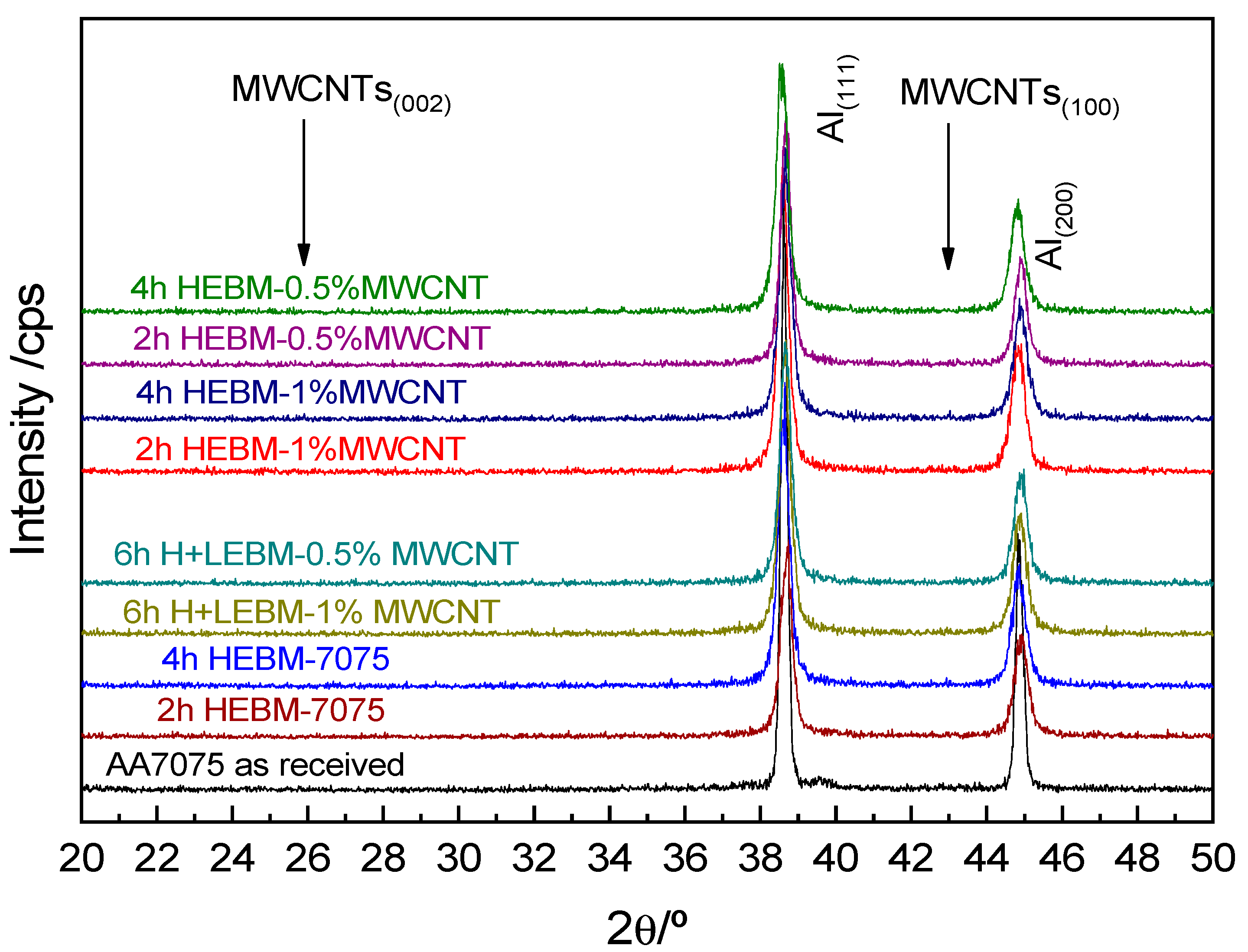

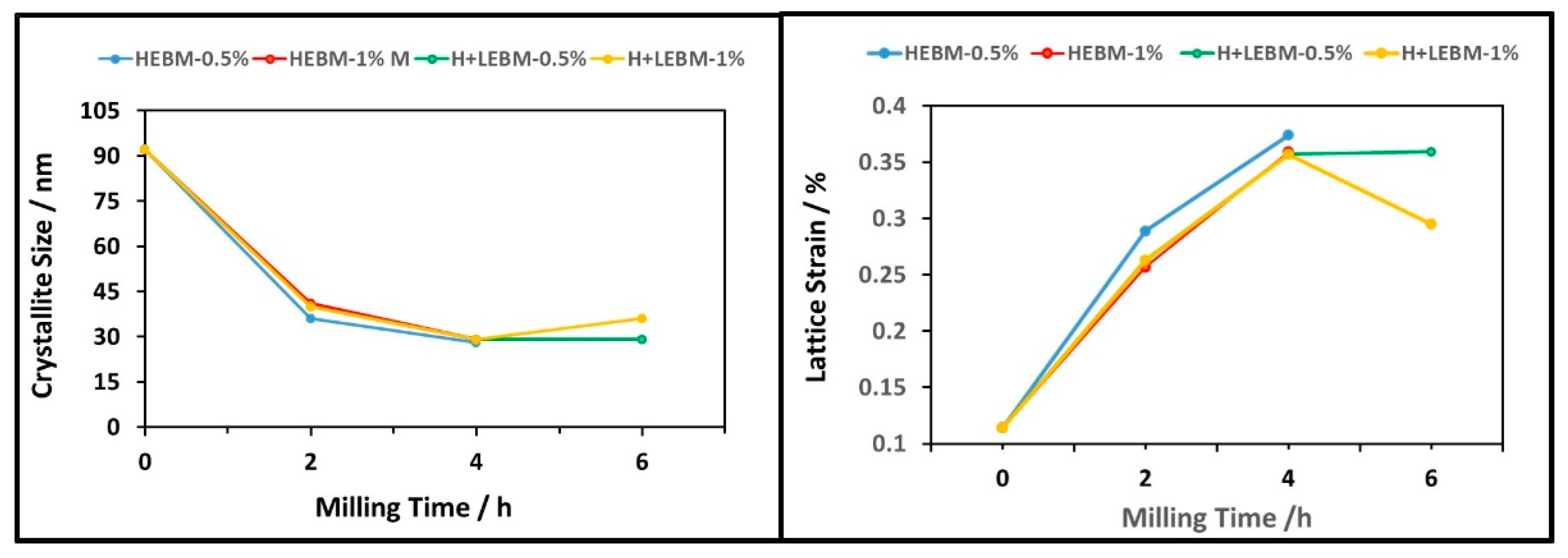
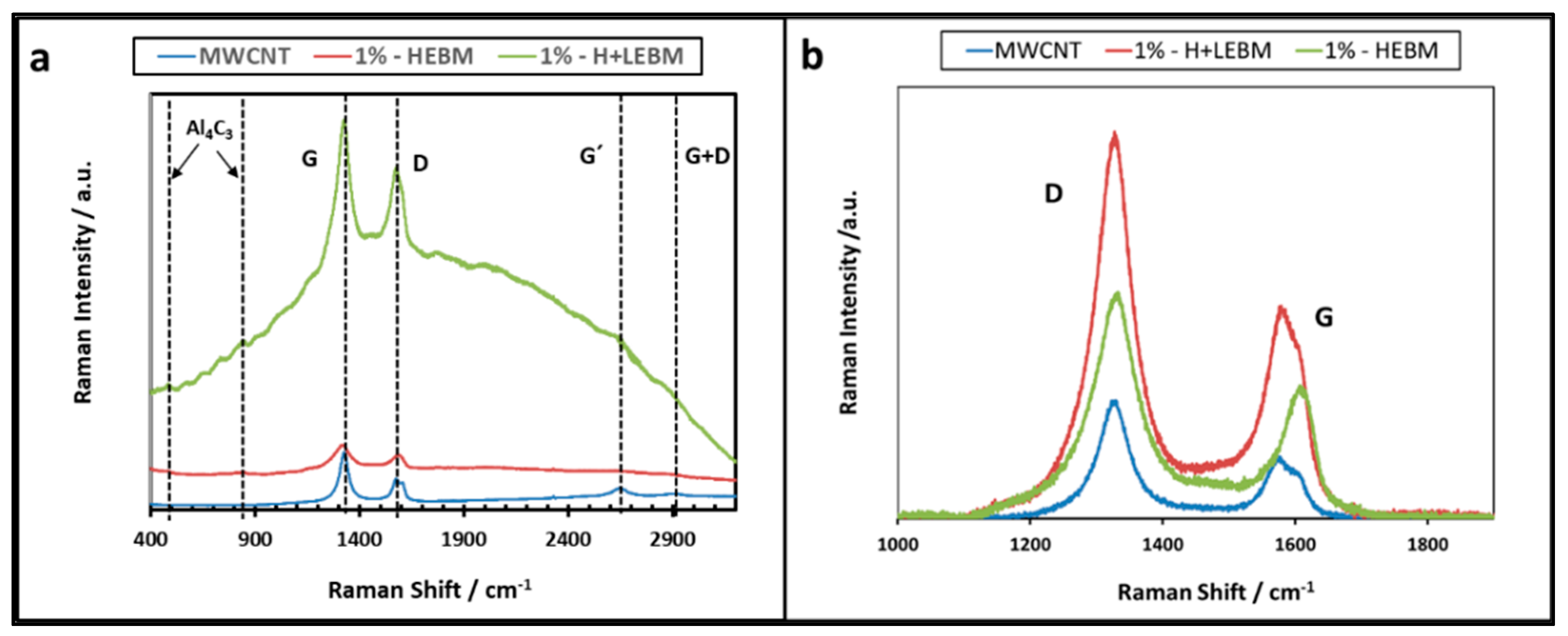
| Ball Milling | MWCNTs | Time (h) | Cycles per 1 min (rpm) | Total Time (h) |
|---|---|---|---|---|
| Low Energy (LEBM) | Yes | 2 | 300/200 | 4 |
| Yes | 4 | 300/200 | ||
| High Energy (HEBM) | Yes | 2 | 1300/1000 | 4 |
| Yes | 4 | 1300/1000 | ||
| High + Low Energy (H + LEBM) | No | 2 | 1300/1000 | 6 |
| No | 4 | 1300/1000 | ||
| Yes | 2 | 300/200 |
| Particle Size (µm) | 0–15 | 15–30 | 30–45 | 45–60 | 60–75 |
| Frequency (%) | 2 | 35 | 41 | 20 | 2 |
| 0.5 wt.% MWCNT Composite | 1 wt.% MWCNT Composite | |||
|---|---|---|---|---|
| Milling Time | HEBM | H + LEBM | HEBM | H + LEBM |
| 0 h | 36 | 36 | 36 | 36 |
| 2 h | 83 | 100 | 63 | 100 |
| 4 h | 72 | 185 | 54 | 185 |
| 6 h | - | 66 | - | 52 |
| Peak Position (cm−1) | ID/IG Ratio | ||
|---|---|---|---|
| D Band | G Band | ||
| MWCNT | 1327 | 1576 | 1.8 |
| 7075-1 wt.% MWCNT HEBM | 1328 | 1607 | 2.0 |
| 7075-1 wt.% MWCNT H + LEBM | 1328 | 1578 | 2.1 |
| Sample | MODULUS E (GPa) | Standard Deviation | HARDNESS H (GPa) | Standard Deviation | RATIO E/H |
|---|---|---|---|---|---|
| AA7075 + 0 wt.% MWCNT HEBM-4h | 71.21 | 7.0 | 3.37 | 0.09 | 21.13 |
| AA7075 +0.5wt.% MWCNT HEBM-4h | 78.26 | 7.4 | 3.73 | 0.28 | 21.00 |
| AA7075 +0.5wt.% MWCNT H+LEBM-6h | 78.62 | 6.8 | 3.30 | 0.45 | 23.75 |
| AA7075 + 1 wt.% MWCNT HEBM-4h | 73.64 | 5.3 | 3.51 | 0.21 | 20.98 |
| AA7075 + 1 wt.% MWCNT H+LEBM-6h | 61.35 | 6.3 | 3.37 | 0.09 | 18.22 |
Publisher’s Note: MDPI stays neutral with regard to jurisdictional claims in published maps and institutional affiliations. |
© 2022 by the authors. Licensee MDPI, Basel, Switzerland. This article is an open access article distributed under the terms and conditions of the Creative Commons Attribution (CC BY) license (https://creativecommons.org/licenses/by/4.0/).
Share and Cite
Feijoo, I.; Pena, G.; Cristóbal, M.J.; Cabeza, M.; Rey, P. Effect of Carbon Nanotube Content and Mechanical Milling Conditions on the Manufacture of AA7075/MWCNT Composites. Metals 2022, 12, 1020. https://doi.org/10.3390/met12061020
Feijoo I, Pena G, Cristóbal MJ, Cabeza M, Rey P. Effect of Carbon Nanotube Content and Mechanical Milling Conditions on the Manufacture of AA7075/MWCNT Composites. Metals. 2022; 12(6):1020. https://doi.org/10.3390/met12061020
Chicago/Turabian StyleFeijoo, Iria, Gloria Pena, María Julia Cristóbal, Marta Cabeza, and Pilar Rey. 2022. "Effect of Carbon Nanotube Content and Mechanical Milling Conditions on the Manufacture of AA7075/MWCNT Composites" Metals 12, no. 6: 1020. https://doi.org/10.3390/met12061020
APA StyleFeijoo, I., Pena, G., Cristóbal, M. J., Cabeza, M., & Rey, P. (2022). Effect of Carbon Nanotube Content and Mechanical Milling Conditions on the Manufacture of AA7075/MWCNT Composites. Metals, 12(6), 1020. https://doi.org/10.3390/met12061020








